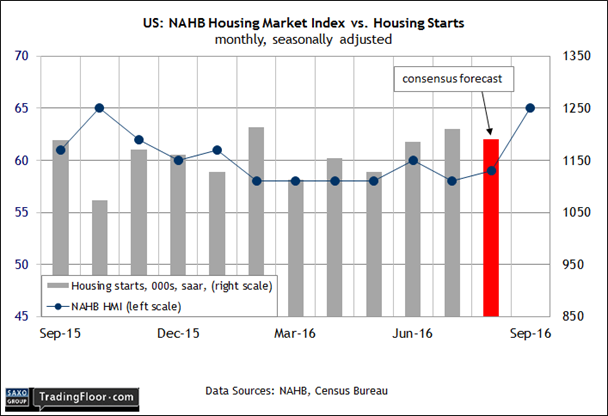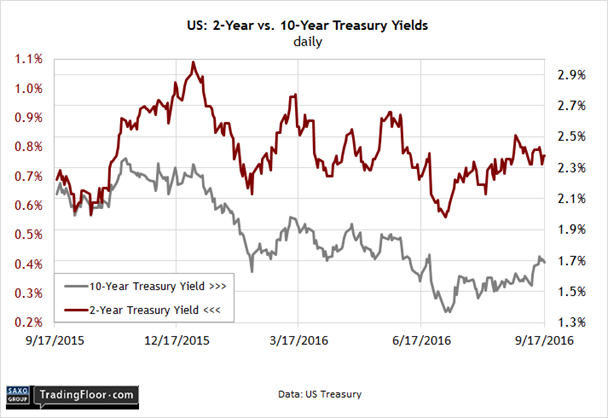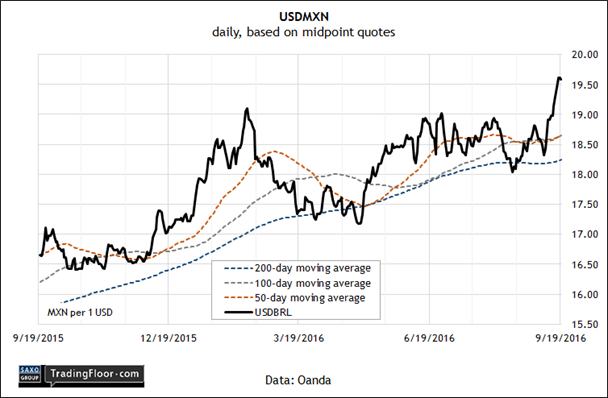- US housing construction expected to edge lower for first time in three months
- Policy-sensitive two-year Treasury yield to remain steady ahead of FOMC
- Is Mexican peso headed for record low exchange rate of 20-to-1 against USD?
It’s a quiet day for scheduled economic news ahead of tomorrow’s monetary announcement from the US Federal Reserve. The main event is the monthly update on US housing construction in August. Meantime, the two-year Treasury yield will likely remain in a tight trading range until the central bank updates its economic outlook and announces if it’s tightening policy (or not). Meantime, keep your eye on Mexico’s stumbling currency: USD/MXN looks poised to reach 20 pesos per US dollar in the near term.
US: Housing Starts (1230 GMT): Confidence in the home-building industry surged in September, according to survey data published by the National Association of Home Builders (NAHB) on Monday. The group’s Housing Market Index (HMI) beat expectations by a wide margin, jumping to 65 for this month’s reading — its highest in 11 months.
“With the inventory of new and existing homes remaining tight, builders are confident that if they can build more homes they can sell them,” says NAHB’s chief economist.
Maybe so, but today’s hard data on residential construction is expected to dip slightly in the August report. Econoday.com’s consensus forecast sees housing starts easing to a seasonally adjusted annual rate of 1.190m — down moderately from a five-month high of 1.211m in July.
Considering the sharp rise in HMI in this month’s data, however, it’s reasonable to assume that a softer reading on construction activity in August will give way to firmer data in upcoming reports.

US: 2-Year Yield: The policy-sensitive two-year Treasury yield has been stuck in a narrow trading range in recent weeks and that’s likely to prevail until we hear from the Federal Reserve via tomorrow’s FOMC statement.
Meantime, the roughly 0.7% to 0.8% band for the two-year yield, which has prevailed since mid-August, endures. “The outright level of yields may remain range-bound unless economic data picks up significantly or central banks make a major shift in monetary policy,” the senior trader at Manulife Asset Management tells The Wall Street Journal.
Monetary policy, however, is expected to remain dull. The crowd projects that the Fed will leave the target Fed funds rate unchanged at the current 0.25% to 0.50% range, according to futures data. The market-based probability of standing pat was 85% as of yesterday, based on CME data.
As for the potential for market-moving economic news ahead of tomorrow’s FOMC statement, the schedule is light. Today’s update on housing starts is a possible catalyst (see note above), but economists are projecting a modest dip, which probably isn’t enough to move yields by much one way or another.
In short, it’s all about tomorrow’s Fed statement and the quarterly update for economic forecasts. Considering last week’s disappointing news on retail spending and industrial activity, the central bank’s revised macro outlook will be widely read, particularly if rates are left unchanged. Analysts at Roubini Global Economics expect that "Fed forecasters will likely cut their growth and inflation projections for the year — hardly an ideal set-up for a rate increase."
Meantime, the two-year yield will probably tread water until the monetary mavens speak.

USD/MXN: It’s been a rough month for the Mexican peso. Last week was especially harsh. Measured in US dollar terms, the peso suffered the biggest haircut among the major emerging-market currencies against the greenback and trading activity so far this week suggests that the bearish momentum will roll on.
As of midday on Tuesday, Mexico’s currency was trading at a record low of 19.6 pesos per dollar. Since September 7, when US presidential candidate Donald Trump made a controversial visit to Mexico’s president, the peso has tumbled more than 7%; year to date, the currency is off 14%.
By some accounts, a weaker currency could be a plus for the sluggish Mexican economy, which is relatively open and dependent on exports to a degree. A falling peso will likely enhance the country’s competitive position, especially with respect to the US, the destination for 80% of Mexican exports.
Mexico can certainly use some extra help after reporting that the economy shrank in the second quarter — the first quarterly decline since 2013. But there are downsides to a falling currency as well, including higher prices via imports for Mexico’s consumers and higher debt-servicing costs — nearly a third of the country’s debt is denominated in US dollars.
For good or ill, the currency’s slide looks set to continue. As of Tuesday, USD/MXN is trading well above its 50-, 100-, and 200-day moving averages (higher USD/MXN values equate with a lower peso vs. the dollar). Short of a miraculous burst of strong economic news for Mexico (and/or troubling macro data for the US), the psychologically significant 20-pesos-to-the-dollar level may be near.

Disclosure: Originally published at Saxo Bank TradingFloor.com
